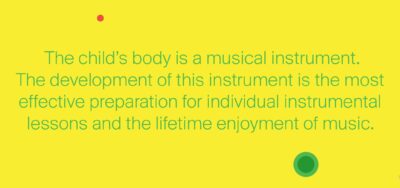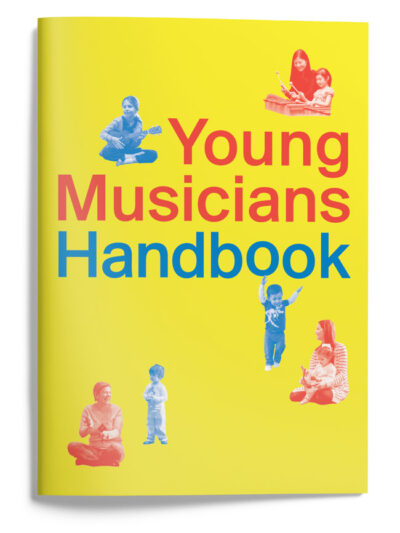
1. Our Philosophy for Early Childhood Music Education
All children are born with musical aptitude. The child’s own body is their first musical instrument. The heartbeat lays the foundation for rhythm. Babbling becomes singing, bouncing becomes dancing, patting becomes playing. The impulse to sing and move rhythmically to music is a natural part of being human.
In Frames of Mind, The Theory of Multiple Intelligences, Howard Gardner posits that music is a unique intelligence among several intelligences, and that “all children are born with innate aptitude specifically related to musical intelligence.” Early childhood is an ideal time to strengthen musical intelligence, but it is never too late to begin.
The Young Musicians (YM) program nurtures developmental growth in a musically rich environment combining movement, listening, singing, touching (playing instruments), and play. The brain/body connection is strengthened by active music making, which leads to improved concentration skills, verbal skills, early literacy skills, and physical coordination. Music class also allows children to explore their imaginations and practice creative decision-making. Students who engage in music making develop a greater sense of self-efficacy, which supports the development of a growth mindset and resilient behaviors.
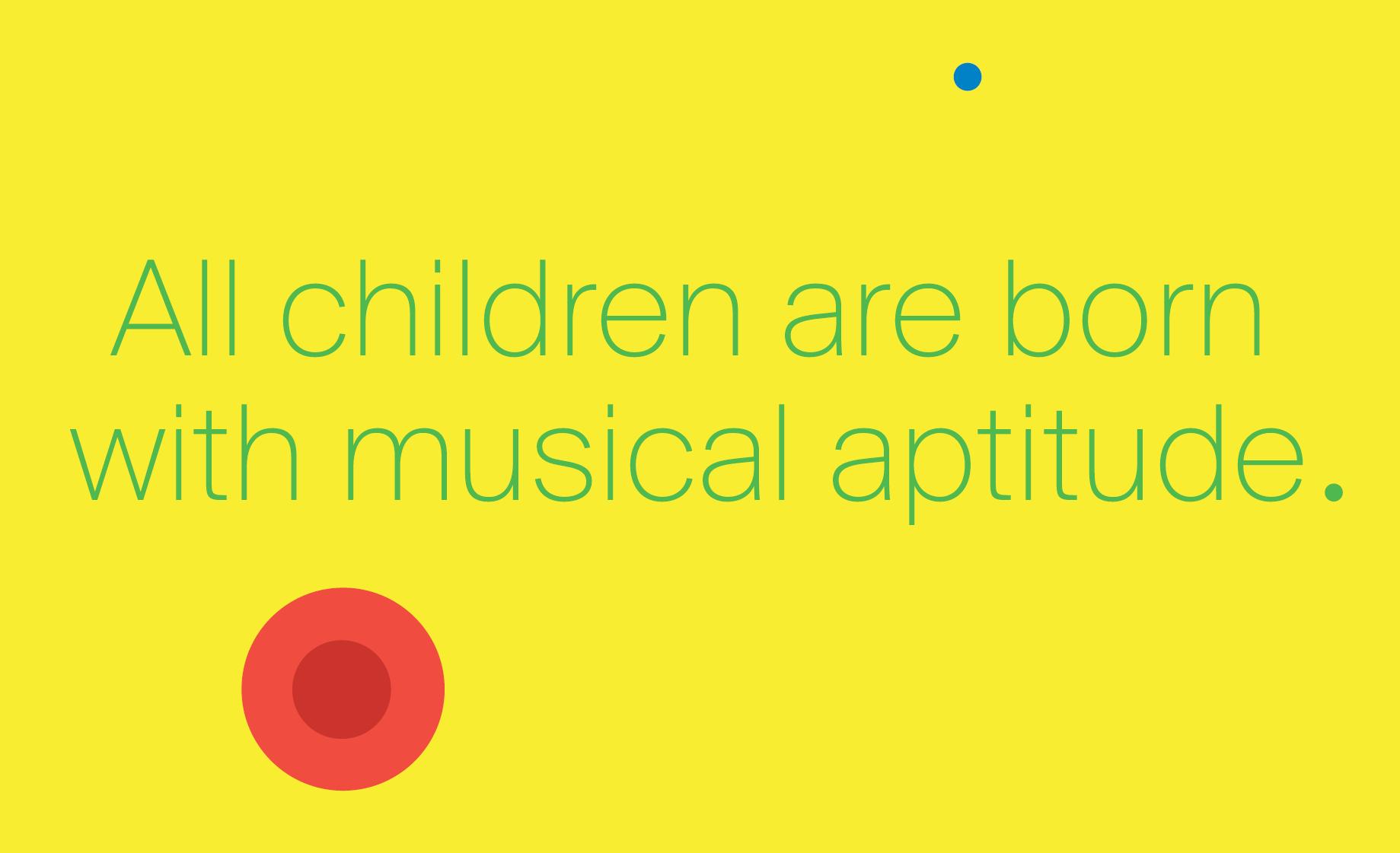
The eclectic YM curriculum is based on contemporary and evolving research and the time-tested teachings of three exceptional early childhood music pedagogues: Orff, Kodàly, and Dalcroze. While there is overlap in their theories, each emphasized different facets of the totality of music-making.
Carl Orff (1895–1982), a German composer and music educator, emphasized elemental music. His model of music-making, Orff Schulwerk, developed with his collaborator Gunild Keetman, is used by teachers worldwide. The Orff process is based upon that which comes naturally to children. In Orff Schulwerk children sing, chant, move, play, and create music. Another highlight is the “instrumentarium,” a set of xylophones based on African, Indonesian, and European instruments. As children play these beautiful sounding instruments, their aural skills expand and they develop a heightened sensitivity to tonal quality and harmony.
Zoltàn Kodàly (1882–1967), a Hungarian composer and music educator, emphasized that children’s folk songs are the most natural starting place for building a musical foundation. Solfege (Do, Re, Me, Fa, Sol, etc.) and rhythm syllables (beginning with ta and ti-ti to represent note values) are employed to develop aural skills as well as tonal and rhythmic competence.
Èmile Jacques-Dalcroze (1865–1950), a professor of music in Switzerland, believed that musicality—the expression of feeling in music—is sacrificed when musical technique is too strongly emphasized in the training of young musicians. As children move to music and express themselves through dramatic play, muscular responses throughout the body are activated, making the whole body the instrument of learning.
2. The Young Musicians Curriculum
Start at an early age with the instrument children are born with: their own bodies. This is the premise of the YM program and the cornerstone of the entire curriculum at Pasadena Conservatory of Music (PCM).
The YM curriculum is designed to
- develop a child’s innate musical aptitude from the earliest ages,
- educate caregivers about the importance of early music experiences for their children, and
- assist families in creating a high quality musical environment at home.
A core concept of the YM curriculum is that the child’s body is a musical instrument, their first instrument. The development of this instrument, the inner musician in each of us, is the most effective preparation for individual instrumental lessons and the lifetime enjoyment of music.
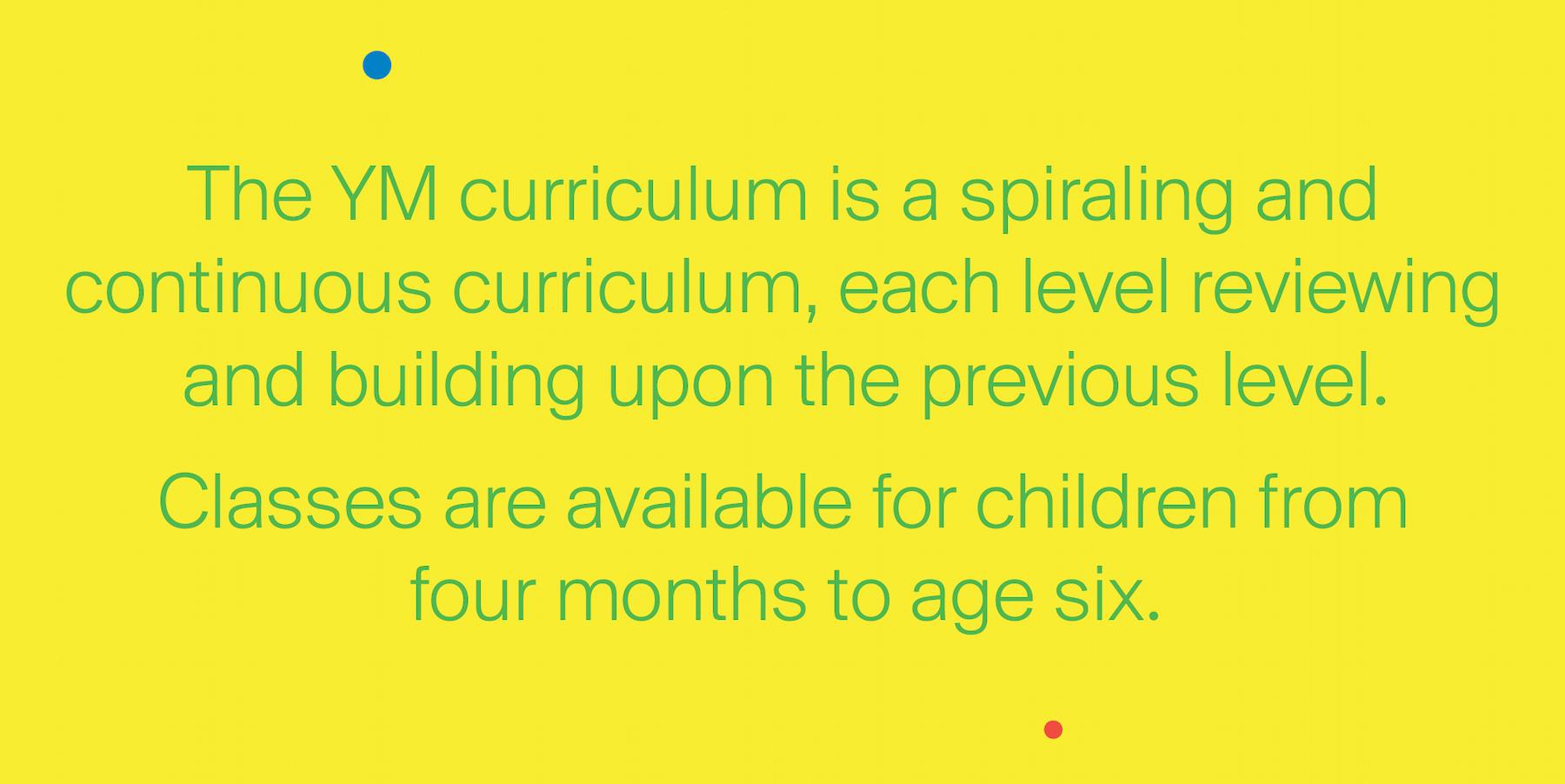
YM classes incorporate listening, singing, music-making, and movement components—the building blocks for developing inner musicianship.
The YM curriculum is a spiraling and continuous curriculum, each level reviewing and building upon the previous level. The curriculum begins with experience-based learning and gradually adds layers of cognitive-based learning.
Classes are available for children from four months to age six. Generally, the student’s age on September 1 determines class placement. The age span for each class level is restricted to twelve months. This allows for highly focused attention on the stages of a child’s development during their formative years.
As the child develops musically, you might wonder when to start learning a specific instrument. The best time to transition to instrumental study is determined by the child’s readiness and the specific demands of each instrument. There are numerous pathways from the YM program to the other departments of the Conservatory as seen in the following illustration
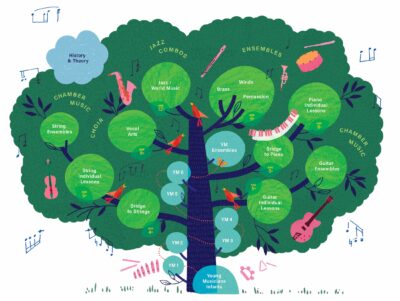
3. The Caregiver Role
What is important to the caregiver becomes important to the child.
There are many cultures around the world where there is a basic assumption that everyone can sing and dance—and they can! We believe that all children can learn to sing and achieve basic music competence. Adult caregivers learn right alongside their children.
A caregiver is required to attend all YM classes through YM5 and Piano Bridge. The caregiver’s role in class is to actively engage in making music along with the teacher to model a love for music and a love for learning. Consistency with the same adult in attendance each week is important.
Caregivers should come to music class ready to sing, dance, move, and have fun! They should have a positive attitude towards themselves, acknowledging their strengths, and allowing the musical areas where they feel weak to develop in class. It is practice and patience with one’s own mistakes that makes the difference. In fact, after attending YM classes with their children, many PCM parents feel ready to take lessons or classes to develop their own musical interests.
Getting the most out of class
Familiar caregivers and loving adults are the first and most important teachers a child will have. With this in mind, here are practical pointers which will help you and your child get the most out of music class:
Feed them and use the restroom as necessary before class, and enter the music classroom ready to learn. Please leave your cell phone and other screens off. If class is already in session, listen for a moment at the door and prepare your child to transition into the class.
Model love and enthusiasm for music and learning. Participate in the activities right alongside the teacher. Feel free to modify physical activities to your comfort level.
Children develop at different rates; accept where your child is at any given moment. We all have gifts, but we open them at different times. Give your child time and space to respond. Sometimes this will not happen in class but in the car or at home. Look for those responses and acknowledge them in a positive way.
If you are sending an alternate caregiver to accompany your child to music class, make certain that they read these guidelines.
Music at Home
Love for music begins, and should continue, at home. PCM teachers will give suggestions and teach adults how to recognize and promote musical behaviors outside of class. Each month, caregivers will receive our Beyond the Classroom flyers with lessons and tips for maximizing musical learning, such as:
- Incorporating music and songs into daily routines
- Learning and practicing familiar songs, as well as creating new versions
- Sharing music listening in a meaningful way
- Suggesting live performances
- Knowing when a child is ready to begin individual instruction on an instrument
Student Absences
Please call the PCM office if your child will be absent from class and leave a message for the teacher. Or, let the teacher know that you will be absent ahead of time.
If children are lethargic and sick, they will not benefit from music class. Please keep sick children at home. You may schedule a make-up class in any available classes at the same level by calling the PCM office.
Teacher Absences
In the event of a teacher emergency or rare emergency class cancellation, you will be contacted by email and/or phone. If a teacher is out sick and a qualified substitute teacher is unavailable, students may attend another class of the same level. In some cases a virtual class may be offered in place of an in-person class. If a teacher has a planned absence and a substitute teacher is unavailable, the teacher will offer a make-up class.
4. Individual Lessons
Before considering individual instrumental lessons
Early musical experiences foster a love for music that will last a lifetime whether or not a child chooses to take individual lessons. Many children are able to enjoy a very rich musical life without studying an instrument. The child will be the best indicator of which direction they want to go. As an alternative, PCM offers group classes after YM6 such as Orff, Recorder, or Choral ensembles for students who want to continue participating in music making without the requirements of individual study.
It is an incorrect assumption that children should begin instrumental lessons at the earliest age possible in order to achieve musical success. Often, adults want their child to begin private instrument study as early as preschool or kindergarten and feel pressured when their neighbor’s child has already begun private study at age 3. Beginning this early may be appropriate for some children, but it is rarely the best choice for most children.
In our experience, waiting to begin instrumental study can yield better long-term results. Beginning with YM classes is a great way to discover, as a family, how to bring music learning into home life. Children become accustomed to attending a music lesson each week and to repeating activities until a skill is learned. Caregivers can observe and discover their children’s aptitude and preferences. Often, children who wait to begin individual lessons catch up quickly and stick with it longer than those who started too early. In the YM program, the inner musician in each child is developed. When the highly complex and technical demands of playing an instrument are introduced, these children experience greater success.
When should private lessons begin?
The Conservatory recommends the following ages for beginning individual instrumental lessons:
Violin/Viola/Cello
Children may begin our Suzuki strings program in kindergarten. In rare cases, children may begin at age 4. Beginners under age 7 are required to take the Bridge to Strings class.
Guitar
Children may begin our guitar program in kindergarten. In rare cases, children may begin at age 5.
Piano
In general, children should have developed basic reading skills and a degree of hand coordination before beginning piano lessons. PCM has developed the Bridge to Piano program for children who are highly motivated to play the piano but may not be physically or academically ready to begin traditional piano study. Bridge to Piano classes begin at age 5.
Woodwinds or Brass
The ideal age varies by instrument, but generally begins in grades 3 through 6. Children must have permanent front teeth and be physically able to hold and blow the instrument. Many PCM students who join the Recorder Ensemble classes make successful transitions to woodwind or brass instruments.
Voice
Children should have group singing experience in their youngest years, such as in a choral group or YM class prior to individual lessons. PCM recommends individual voice lessons begin at age 9 or older.
Percussion
Individual study of percussion techniques requires great dexterity and application. Orff Ensemble classes can serve as a bridge to individual percussion lessons which begin at age 10.
